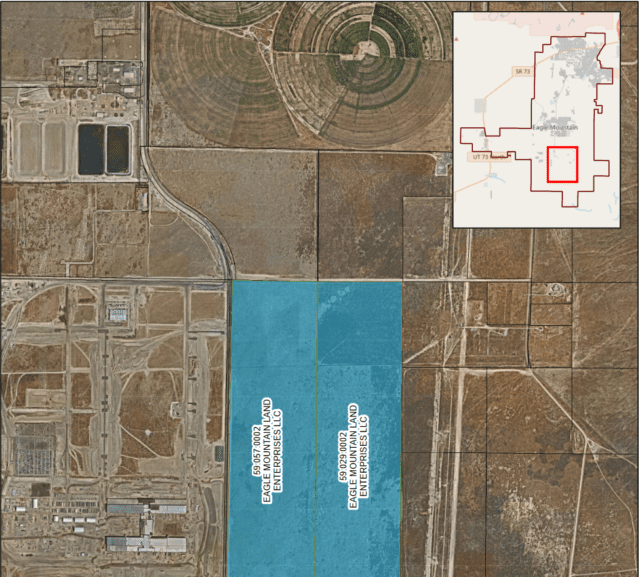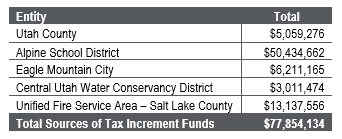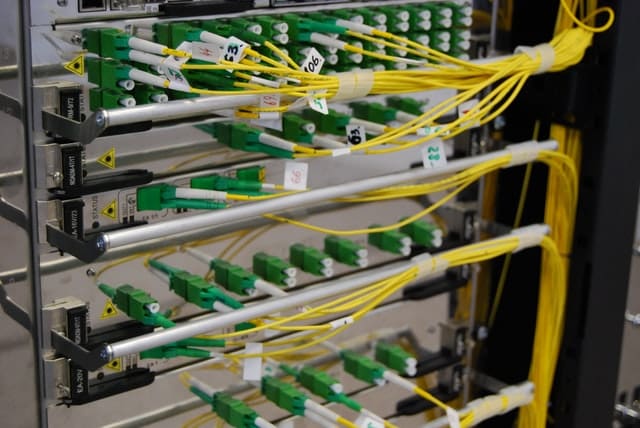A public notice has been made by the Eagle Mountain City Redevelopment Agency that it will be holding a Public Hearing on February 16th, 2021 in regards to a project called the SWEETWATER INDUSTRIAL PARK COMMUNITY REINVESTMENT PROJECT AREA #2. The Facebook data center is located in the Sweetwater Industrial park and is adjacent of the proposed lots. There is a proposed $77 Million property tax “reinvestment” that will be voted on. A Technology and Industrial overlay zone was applied and approved to that area in April of 2020. “BACKGROUND: (Presented by Staff) In order to create a CRA, a Redevelopment Agency(RDA) must first designate a study area as well as create a project area and budget for a proposed use in that area. Motion to approve. The proposed resolution designates a SurveyArea known as Sweetwater Industrial Park Survey Area #2. The 320-acre parcel is located in the south service area of the City, east of the Facebook data center.” This zone approval was one of the first steps towards the building of the second large scale data center in Eagle Mountain.
The DRAFT project area plan for this Community Reinvestment Area (CRA) gives us some more details. The CRA plan defines the area as: “The Project Area lies within the southern portion of the City, generally to the west of Lake Mountain Road, east of Pony Express Parkway, and to the north of 1000 North. All of the land use in the project area is currently vacant. The Project Area is comprised of approximately 327.85 acres of property.” It also defines the land use as: “It is anticipated that future development within the Project Area will create space for a data center. Other supplementary development may take place during future phases of the development.”

The Draft CRA project area plan includes the following statements on the impact it will have on the surrounding areas physical, social, and economic conditions.
Physical Conditions
The Project Area consists of approximately 327.85 acres of relatively flat, privately owned land as shown on the Project Area map.
Social Conditions
The Project Area experiences a lack of connectivity and vitality. There are no residential units and no parks, libraries, or other social gathering places in the Project Area. This is in line with the contemplated uses of the area surrounding the Project Area which is currently under the greenbelt classification or used for similar types of development as contemplated in the Project Area.
Economic Conditions
The Project Area is currently under greenbelt classification. The Agency desires to encourage development within the Project Area that will directly benefit the existing economic base of the City, Utah County and other taxing entities.
The notice indicates that there will be a $77 Million dollar re-investment associated with the property.
“The Agency has requested $77,854,134 in property tax incremental revenues that will be generated by development within the CRA to fund a portion of the project development costs within the CRA. These property tax revenues will be used for the following:”

“These property taxes will be levied by the following governmental entities, and, assuming current tax rates, the taxes paid to the Agency for this CRA from each taxing entity will be as following:”

“All of the property tax increment to be paid to the Agency for the development in the CRA are taxes that will be generated only if the CRA is developed. ”
NOTE: I need to note here that these amounts have not been approved by the taxing entities at the time of publication of this article. The entities will still need to each vote independently on the incentives as well as hold a public hearing.
The Draft Project Budget states that at the end of the project the Total Annual Property Tax Revenue for Taxing Entities at Conclusion of Project will be $3,656,810 annually. “As described above, the collective taxing entities are currently receiving approximately $25 in property taxes annually from this Project Area. At the end of 20 years, an additional $3,656,786 in property taxes annually is anticipated, totaling approximately $3,656,810 in property taxes annually for the area. “But for” the assistance provided by the RDA through tax increment revenues, this momentous increase in property taxes generated for the taxing entities would not be possible.
The area of the project was previously added to a Regional Technology and Industry Overlay Zone. City codes currently states that this zone has the purpose of, “The regional technology and industry overlay zone is intended to provide for the development and operation of large-scale technological, clean industrial, distribution, and high-tech manufacturing uses that will increase the tax base and provide jobs for the city’s residents. The standards and processes of the base or underlying zone shall be applicable unless modified or replaced by this overlay zone.”

Because the project is in an RTI Overlay Zone, it has a special approval process. That process does not include any type of public hearing, and will not go before the Planning Commission or City Council for approval. I would like to note that the City Council and Planning Commission have to approve an area to be part of a RTI overlay zone. Once the zone is applied, development only has to be approved by the Development Review Committee, and then the City Council informed by a liaison. “Development review committee or “DRC” shall be chaired by the planning director, or his designee, and shall include, at a minimum, the city attorney, the department heads or an assigned representative from public works, community development, and engineering, and a representative of Unified Fire Authority. The planning director shall have authority to issue decisions or approvals on behalf of the DRC once the planning director has consulted with all the DRC members. The appointed economic development board liaison will serve as DRC liaison to city council.” “Approval Authority. The DRC has final approval authority for RTI applications. No public hearings are required.”
I contacted the city recorder’s office to find out who is currently on the DRC. “Our DRC consists of the Community Development Director, Planning Manager, Senior Planner, Planner, City Engineer, Engineering Tech, Parks and Recreation Director, Public Works Inspector, and Unified Fire Authority Area Fire Marshal. Direct Communications is invited as a utility/service provider. The liaison to the Planning Commission has attended DRC meetings in the past, although there is no appointed liaison specifically for the DRC.”
The positions are currently held by the following people:
- Steve Mumford, Community Development Director
- Pete Kane, Planning Manager
- Tayler Jensen, Senior Planner
- Jessa Porter, Planner
- Chris Trusty, City Engineer
- Robert Ballif, Engineering Tech
- Brad Hickman, Parks and Recreation Director
- Marty Bahr, Public Works Inspector
- Unified Fire Authority Area Fire Marshal Dan Devoogd
I would at this point like to point out as well, that all of the members of this board are City Staff, non of them are Elected Officials. Once the Overlay was put into place, the decision authority is removed from elected officials and given directly to City Staff. At this point, the planning commission and city council are informed of decisions and are not making them. The only input elected officials now have is through their membership in the Redevelopment Agency. A major concern with the overlay zone is that the City Council in previous decisions were only brought into the discussion at the very tail end. This is something that was a concern for Councilmember Curtis during the April 21, 2020 meeting. “Board Member Curtis expressed concern that the Board does not have input during the negotiation phase of the project and stated he wants the Board to be part of the monetary negotiations of the project before the item returns to the board for a vote. he requested acknowledgment from City Adminsitroatr Ifo Pili and Mr. Sanborn assuring individual discussion with Board members during negotiations to determine RDA increments.”
Supporting Documents
Note: The following two documents were requested for my preview, but because of COVID-19 they were sent to me electroniclly. Here they are for your reivew as well.
Mike Kieffer – Editor-in-Chief, Cedar Valley Sentinel
Mike Kieffer is a dynamic leader and community advocate based in Eagle Mountain, Utah. He serves as the Editor-in-Chief of the Cedar Valley Sentinel, a local publication dedicated to informing, inspiring, and elevating the Cedar Valley community through honest and accurate journalism. With a passion for fostering connections, Kieffer has made it his mission to highlight local businesses, provide reliable news, and support community development.
Beyond his editorial role, Kieffer is the owner of Lake Mountain Media, LLC, a company specializing in media and communications, and the co-owner of Quail Run Farms, which focuses on sustainable farming and community engagement. He also actively contributes to the local economy and culture as a member of the Eagle Mountain Chamber of Commerce.
Kieffer’s dedication extends to preserving and promoting the history and heritage of the Cedar Valley area. He often participates in community-centered events and media, including podcasts that explore the unique aspects of life in the region. Through his varied endeavors, he remains a steadfast advocate for the growth and enrichment of the local community.

